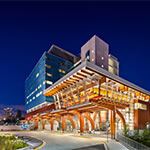At first glance, Surrey Memorial Hospital’s Critical Care Tower in British Columbia doesn’t look like the kind of building that would house top-notch medical care. The angular, artistic shell of the new expansion, designed by CEI Architecture with Parkin Architects, looks more like a hotel or resort than one of Canada’s largest healthcare facilities. The entry is warm, welcoming, and engaging, unlike many hospitals, which often favor antiseptic aesthetics.

The warm aesthetic continues in the main lobby, enhanced by the multistory glass curtainwall and yellow, orange, and red baffles hanging from the ceiling.
Construction for the new wing of the existing hospital broke ground in 2011 to support Surrey, one of the fastest growing municipalities in Canada. The $512 million, 420,000-square-foot addition officially opened in June 2014, complete with 151 new acute care beds, a specialized mental health and pediatric area, new labs, space for academics, and the second largest emergency department in the country.
Within the rigid design structure set forth by the commanding public-private partnership, the architects worked to execute the technical requirements of the project while also creating a comfortable environment for patients and visitors. “It’s a real shift in how healthcare is being reconceived,” says Allan Francis, a sustainable design specialist with CEI Architecture and a member of the design and construction team. “On a small, or even a really large scale like this, people are coming to the realization that the attributes of the interior environments—such as air quality and access to natural light—are as important for our health as the clinical care you are receiving in that environment.”
To establish as natural an environment as possible, natural materials, daylighting, and ventilation were incorporated into the design—elements that also contribute towards the project’s LEED Gold target. One striking element that weaves throughout both the interior and exterior of the building is the use of local wood, which fosters feelings of warmth and also fits within the guidelines of British Columbia’s 2009 Wood First Act, where local businesses are required to consider wood as a primary building material in all publicly funded buildings.
Natural light also plays an important role in the design. Iain MacFadyen with Enermodal Engineering, the firm selected to provide sustainability coordination for the project, said that because the building has dense massing, CEI oriented working spaces that do not require natural light towards the central core, leaving patient rooms and other social spaces around the perimeter. Each room features occupancy and daylight sensors and high-performance windows. Preliminary energy models project 47 percent energy savings when compared to the energy cost of the model building code.

Surrey Memorial’s use of local wood exceeded the guidelines of BC’s Wood First Act, which applies to all publicly funded buildings in British Columbia.

Healthy materials were used to construct the new healthcare facility in an effort to create as healing an environment as possible.

CEI deliberately placed spaces that don’t require natural light toward the middle of the building, thereby reserving all sunlight for patient rooms and social areas.

